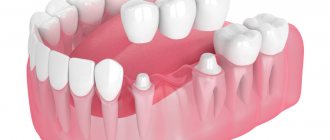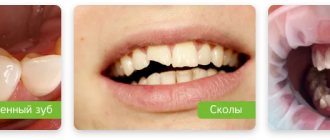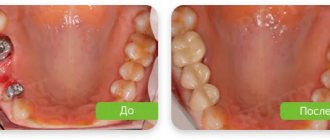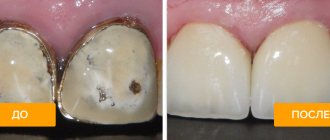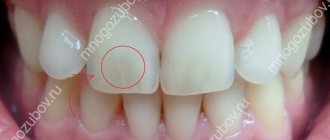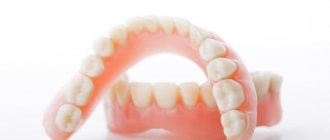Ideal teeth size
In dentistry, teeth of a certain size and anatomical shape are considered normal, depending on the size of the jaw and their location in it. They must be smooth, fit tightly to each other and have a thickness within certain limits: for example, the height of the lateral incisors in an adult is normally 7 - 11 millimeters. Of course, this does not mean that they need to be measured with a ruler - overall aesthetics and proportionality are much more important (for example, for people of short stature and fragile build, a small teeth size is appropriate). Many parents are interested in why their child has small teeth, but usually there is no reason to worry: normally, the baby incisors are small and located at a distance from each other.
However, if the patient really has very small teeth, you should definitely consult a dentist to confirm or exclude the diagnosis of microdentia.
Composite veneers
The color of composite veneers is able to convey the shade of natural enamel. But the type of finished product largely depends on the skill of the doctor. Since the composite is applied in layers, the dentist uses different shades, from darker to lighter, and the result is an imitation of a natural tooth. Composites are strong, they are used for veneers and restoration of dental crowns, but they are inferior in strength to ceramics.
Photopolymer overlays fade over time
, so the initial shade should be lighter than the desired one. When installing composite veneers, you should keep in mind not only the price, but also the service life. It is several times shorter for composites than for ceramics, including due to the fact that composites change color.
Diagnosis of microdentia
According to statistics, about 5% of people face the problem of microdentia – abnormally small teeth in an adult. There are several signs that allow you to distinguish microdentia from other dental pathologies.
Symptoms of microdentia
- teeth of regular shape, but with a significantly reduced crown;
- distances between teeth visible to the naked eye;
- damage mainly to the front teeth;
- wavy or jagged shape of the cutting part of the affected tooth.
In most cases, the presence of microdentia can be determined by visual examination of the patient, but for a more accurate diagnosis, hardware diagnostics are performed. For example, the doctor can measure the overall width of the incisors of both jaws using a special instrument, as well as resort to x-rays. A deviation is considered to be a reduction of teeth by 1.5 mm or more relative to the norm. Based on the results of the examination, one of three types of microdentia is determined.
Isolated
If the patient has one or two small teeth, then we are talking about isolated microdentia. Most often, the front incisors (mainly the lateral incisors) are underdeveloped.
Relative
Relative microdentia is said to occur when the patient has an abnormally enlarged jaw. On such a jaw, even normal-sized crowns can look disproportionately small. Thus, relative microdentia is an overly large gum and small teeth on it.
Generalized
In the most severe cases, when small teeth are located throughout the jaw, the patient is diagnosed with “generalized microdentia.”
Orthodontic treatment
Braces
- a truly unique invention that can help with very, very many problems. In most cases, they really help with different lengths of the front teeth - especially if the incisors look shorter than the other due to an incorrect position in the mouth: for example, one is strongly tilted back or forward, or has grown slightly behind or in front of the other.
This treatment will be long-term, but the most effective of all other methods of straightening teeth of unequal length. In a certain way, tightened braces are quite capable of both “pulling out” a tooth that sits too deeply in the gums and “sinking” an excessively protruding one.
In any case, the need for treatment with braces and a suitable brace system will be determined by the dentist at the appointment. Even if the defect is too large and cannot be completely corrected with braces, orthodontic treatment
will significantly reduce visual unevenness, and in addition will help to avoid a number of other problems with malocclusion.
Reasons why teeth become small
As a rule, most of the reasons leading to the appearance of small front teeth in adults come from childhood, when pathological processes interfere with the formation of body systems. Microdentia can be a consequence of:
- severe infections suffered before the age of 2 years;
- exposure to radiation;
- inflammatory diseases in the mother during pregnancy;
- early removal of baby teeth;
- underdevelopment of the alveolar ridge and, as a consequence, lack of sufficient support for “growing” teeth of normal size.
Dangerous consequences of microdentia
At first glance, it seems that small teeth in an adult cause only aesthetic inconvenience, but this is not so. Dentists identify several quite serious problems that microdentia can lead to.
- Distal displacement of teeth,
that is, their gradual shift back relative to the optimal position in the jaw. - The appearance of gaps between the teeth
(the so-called diastemas and threes), which lead to disruption of the contact of the lateral surfaces of the teeth. Without support, the ligaments in the dental bed stretch and the tooth becomes unstable. - Diction disorders,
excessive amplification of hissing and whistling sounds in speech. - Periodontal disease
is a disease of the soft tissues of the jaw, caused by accumulations of bacteria in the interdental spaces and an enlarged periodontal pocket due to the high mobility of the tooth.
How does crowded teeth occur?
The development of clinical symptoms is due to the fact that there is not enough space on the jaw for the teeth to take the correct position. This may be due to its insufficient size, too large teeth, their excessive number, or overcompleteness. In adult patients, the development of anomalies is most often caused by pressure on the dentition of the erupting eights, which affect neighboring teeth, leading to their displacement and crowding.
Stages and symptoms of the disease
A predisposition to the development of anomalies can be identified already in early childhood by contacting an orthodontist. During the examination, the specialist will find that there is no gap between the child’s baby teeth. This sign indicates that, with a high degree of probability, there will be no room for erupting teeth in the permanent dentition. As they appear, the problem will only get worse. Timely identification of negative factors in children would help normalize the situation even at the stage of primary occlusion. However, specialists very often encounter the fact that even with congenital prerequisites, patients turn to a specialist only during the period when the permanent dentition is fully formed and clinical signs are evident.
The anomaly is characterized by varying degrees of severity, which determines clinical symptoms and possible complications. The degree of development of pathological signs also affects treatment tactics, as well as prognosis. Depending on the symptoms of dental crowding , there are 3 degrees of damage.
- A mild degree of anomaly is characterized by minimal changes in the position of 1-2 teeth in the dentition. For them to take the correct position, only 2-3 mm are missing. The problem does not apply to the remaining teeth; they occupy a clearly defined place;
- With a moderate degree of anomaly, the problem also affects only single teeth. They are rotated around their axis, shifted relative to the dentition, and can be tilted. Their displacement corresponds to 5-6 mm;
- In the case of a severe anomaly, its manifestations are clearly visible to others. The aesthetics of the smile are compromised due to deformation of the dentition ; some teeth are pushed out of the dentition. The shape of the arc appears to be changed.
The main disadvantage caused by the anomaly is that crowding of teeth leads to deterioration in the aesthetics of the dentition. This is especially noticeable with severe damage. However, this problem is not the only one.
With this position of the teeth, the possibilities for high-quality cleaning procedures are noticeably deteriorated. The prerequisites will be created for the formation of plaque, which will affect the change in the shade of the enamel, manifest as tartar deposits, and the presence of bad breath. Lack of proper hygiene will lead to the development of other diseases of the dental system and the appearance of additional symptoms. In addition, incorrect position of the teeth can contribute to injury to the mucous membranes. Symptoms will be supplemented by such manifestations as bleeding, inflammatory or erosive process.
Possible complications if left untreated
Crowding of teeth is dangerous not only due to aesthetic problems. Lack of proper care contributes to the deposition of plaque and, as a result, the development of caries and various periodontal diseases. At the same time, the pathological process often begins in hard-to-reach places, interdental spaces, which complicates its diagnosis by visual methods. Such patients turn to specialists already in the presence of pronounced signs of caries or its complications. Late treatment is dangerous because during treatment it is not always possible to save the tooth.
Insufficient oral hygiene and plaque deposits contribute to the activity of pathogenic microorganisms in the oral cavity with the development of gingivitis, periodontitis and periodontal disease. If treatment is delayed or the measures taken are incorrect, the consequences of violations may be increased mobility of teeth, and even their loss.
Is treatment necessary?
The choice of treatment tactics for crowded teeth depends on the degree of development of the anomaly. However, experts are unanimous in the opinion that correction is necessary even with minimal aesthetic disturbances that are hardly noticeable during articulation. If you ignore orthodontic treatment, there is a risk of developing dental pathology due to insufficient preventive measures.
The consequence of the caries process and tooth loss can be disruption of the functioning of the temporomandibular joint, difficulty chewing food and the development of gastrointestinal disorders. Improper closure of the dentition is one of the possible causes of headaches and insomnia. Due to the unevenness of the load, such a predisposing factor will contribute to the rapid wear of the teeth that are most involved in chewing movements.
Treatment methods for crowded teeth: Daimon Q braces, aligners, plates, separation and extraction
The choice of the optimal correction technique is determined based on the results of the diagnostics performed, which makes it possible to clarify the volume and condition of the bone tissue, the position of each tooth, and its parameters. The most popular are orthopantomogram, teleroentgenogram and computed tomography. Based on the results obtained, a treatment plan is drawn up.
Treatment of crowded teeth should begin as early as possible, especially if the cause of the presence of pathological signs is insufficient development of the jaw. An anomaly caused by jaw characteristics is more difficult to correct, especially when contacting specialists late, when the bones are fully formed. Orthodontic devices such as removable plates, dental trainers , activators, palatal expanders will be effective only in children, since their jaw bones are still in the developmental stage and are better amenable to correction.
By the age of 12, wisdom teeth begin to form: their rudiments can be diagnosed through x-ray studies. The further action plan is based on this factor. If it becomes clear that there is not enough space for the development of eights, a decision will be made to remove them in an unerupted state.
Moreover, in adult patients, not only eights are removed. The need for tooth extraction is also due to factors such as supernumerary and macrodentia. In addition to eights, it is often necessary to remove fours or fives. By removing 2 teeth, you will be able to free up about 6 mm of additional space. This will create the prerequisites for straightening the dental arch. To increase the effectiveness of the result and force the teeth to move in the desired direction, braces or aligners are subsequently used in adult patients.
In addition to the use of orthodontic systems, other treatment options are used. One of them is separation, that is, grinding the contact surfaces of permanent teeth. During such an event, specialists use a bur to remove about 0.5 mm of the contact surface of the tooth. Having received additional space, the prerequisites for teeth straightening appear. As in every orthodontic technique, in this case the professional skills of the specialist are extremely important. When excessive amounts of tooth tissue are sanded off, it becomes sensitive to the effects of negative factors. This is accompanied by unpleasant sensations, and too thin a layer of enamel increases the prerequisites for the development of the carious process.
Treatment of crowded teeth in adults
In adults, treating crowded teeth in the lower jaw is a more common procedure than correcting the same anomaly in the upper jaw. The choice of treatment tactics in this case is made depending on the severity of clinical signs, as well as the factors that contributed to the development of the anomaly. Since most often the problem lies in the dystopic position of the eights, which has a negative impact on other teeth in the row, their removal is the initial stage of orthodontic correction. With macrodentia, extraction may also affect other teeth. Some improvement in the situation is also achieved by tissue separation.
Minor imperfections can be hidden by installing ceramic onlays and veneers. To ensure a strong fixation, in this case it will be necessary to slightly grind down the front surface of the tooth. This procedure falls under the competence of an orthopedic dentist. However, in this case we are not talking about correcting an orthodontic disorder, but only about leveling out aesthetic deficiencies.
In adults, dental crowding in the lower jaw is most often treated with braces. The same approach is taken as a basis for the development of anomalies in the upper jaw. Braces systems are non-removable orthodontic devices that are installed for the entire period of corrective measures. The main element in them are clasps that are fixed to the tooth surface, and a durable metal arch. It is its elasticity and the desire to take its original position that contribute to the movement of teeth. Fastening the arch to the locks is ensured using ligatures, rubber bands and wire, or by means of a special device that fixes the clips mounted in the lock. Such technical features determine some features of the functioning of the devices.
Treatment methods with and without braces
If teeth are crowded, treatment without braces is also possible in adults. An alternative is to use aligners. These removable mouthguards are made in strict accordance with individual parameters. By firmly installing on the dentition and causing pressure on it, they contribute to the displacement of teeth in a given direction. The patient wears the system for two weeks. After that, he changes it to the next model, which is slightly different in its physical dimensions. This treatment differs from braces in that it remains invisible to others.
High-tech production of aligners allows you to create ultra-thin and completely transparent models. They are invisible on the teeth, so the correction process is highly aesthetic. The ability to remove aligners as needed and ease of care make it possible to completely prevent damage to tooth enamel and make treatment safe.
Braces, aligners and plates
Treatment with braces has been carried out for half a century. Over the years, the technical characteristics of the locks have changed significantly; models have appeared in which there are no ligatures that secure the arch. Significant changes affected the possible design of braces and the material used to make clasps.
At the same time, the demand for aligners for teeth straightening is due to their high efficiency, almost comparable to braces, and excellent aesthetic properties. Patients who are interested in the treatment being invisible to others and who have the financial means to carry it out with the help of aligners, choose such systems.
As for the expansion plates, their action is aimed at gradually leveling the jaw row through systematic pressure on it. The functioning of this design is ensured by the elasticity of the plate, fastening screws and a spring, and fixation on the teeth is carried out using hooks. Despite the fact that the effectiveness of the systems is due to individual manufacturing, their use is more relevant in adolescents until the jaw bone is fully formed.
Crowding and wisdom teeth
Wisdom teeth are the last to appear, by the age of 20-25, when the bone tissue is formed and has reached its maximum density, so their eruption is often difficult. They can rest against the bone or adjacent teeth, putting pressure on them and displacing them. There is often no place left for them due to evolutionary processes.
The combination of all these factors leads to the fact that the eruption of wisdom teeth is accompanied by pericoronitis, up to abscess and phlegmon, resorption of the root of the adjacent tooth, as well as crowding of teeth. You can identify the problem in advance by contacting a specialist and carrying out appropriate diagnostics. Already on the basis of a panoramic image, it will be possible to determine all the negative factors associated with the eruption of figure eights, and prescribe additional studies and corrective measures.
How to fix small teeth?
Small tooth: what to do if it causes inconvenience, reduces self-esteem and worsens quality of life? Depending on the severity of the picture, the dentist may suggest the following correction methods:
- In case of isolated microdentia, small teeth can be corrected by installing veneers or lumineers - thin plates that are attached to the front surface of the tooth. This method is also suitable for eliminating threes and diastemas and increasing the width of the visible part of the crown. If your teeth grow unevenly, you will most likely need orthodontic correction using braces before placing veneers.
Teeth filing
If the difference in the length of the teeth is too noticeable and prominent, you can resort to filing the teeth. This procedure is performed for various deficiencies in the dentition: if the edges of the teeth are too sharp and scratch the cheeks and gums, or if the shape of the teeth is too triangular, as well as before installing crowns or veneers and before starting orthodontic treatment in some situations, the teeth are filed down to make room for further shift.
When filing (grinding) teeth, a permissible layer of enamel is removed. However, during the process, excessive sensitivity of the teeth may occur - this defect is corrected by several procedures for remineralization and fluoridation of the enamel
.

